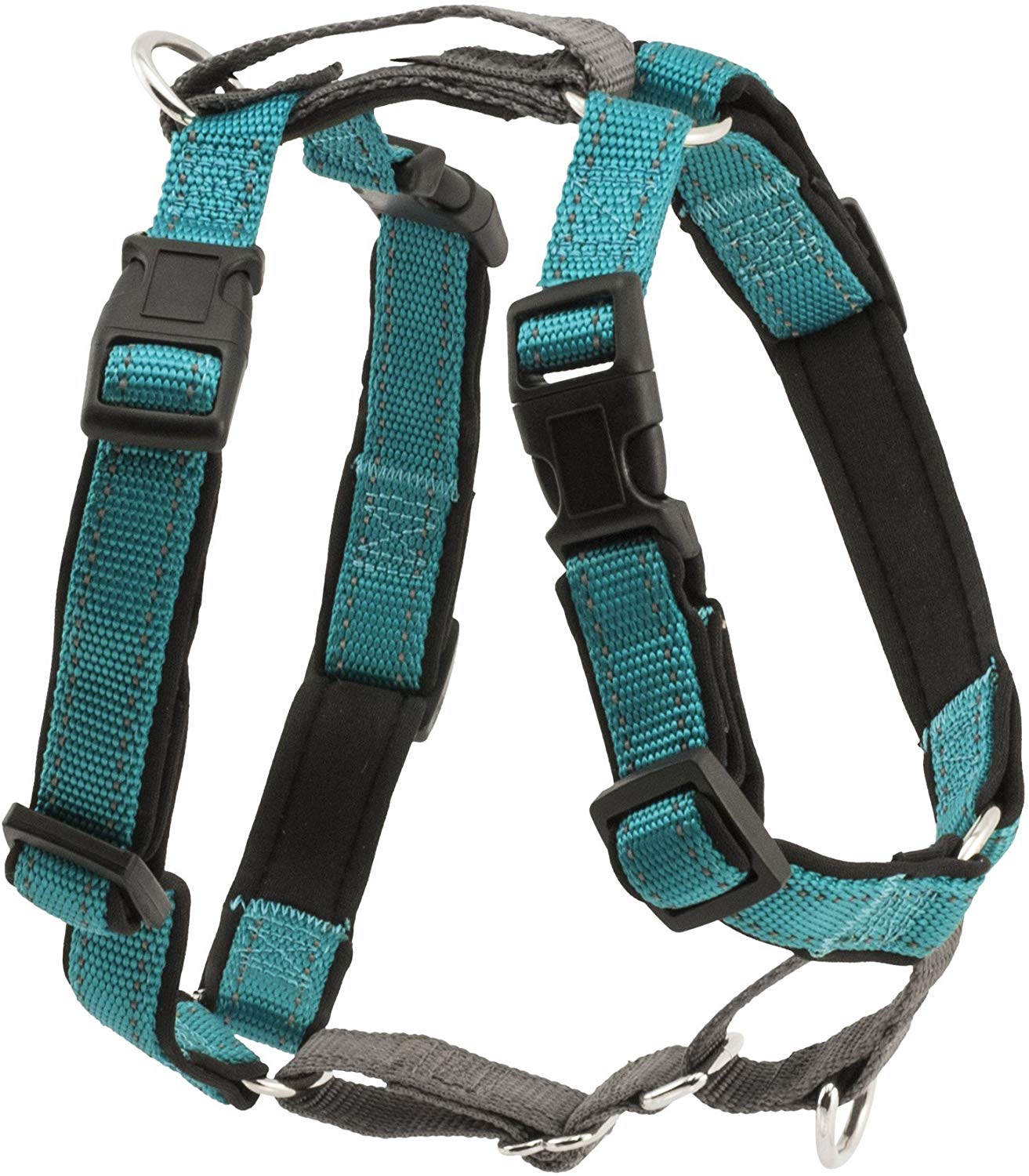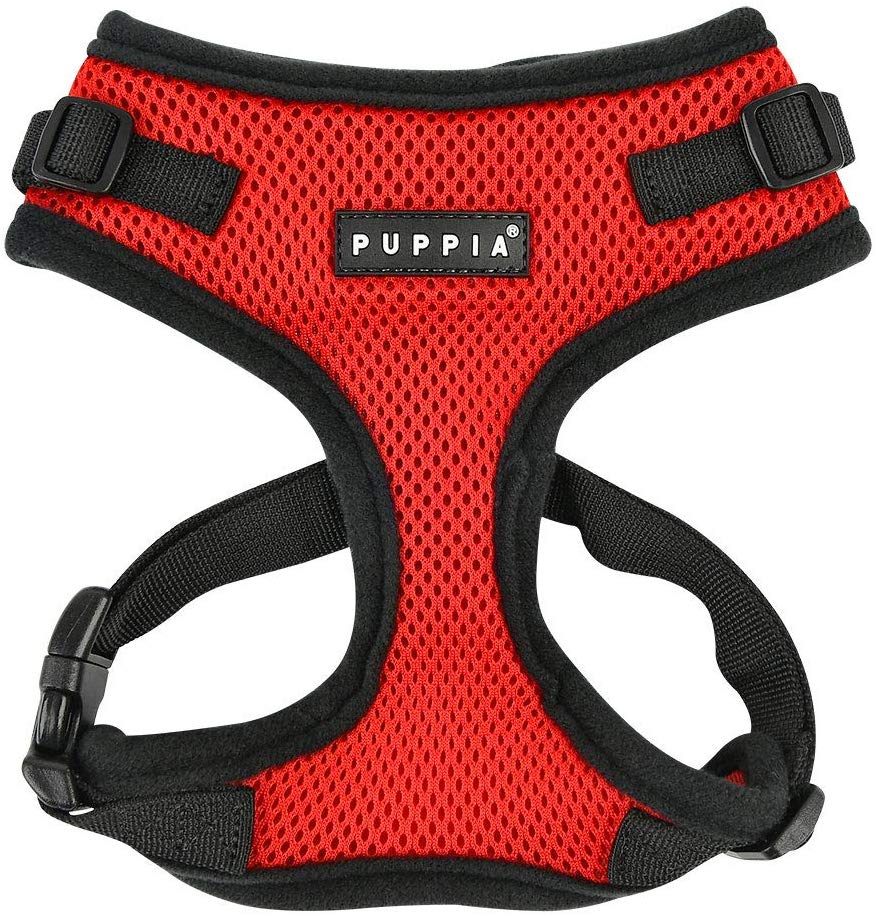Keep Your Dog Comfortable Using the Best Dog Training Harness
Dog walkers will agree that controlling an aggressive dog or a dog that pulls can be tricky, and that's when using a collar would only hurt your dog's neck. To protect your dog's neck and trachea, you need to be looking for something better, and dog harnesses are what dog walkers choose in this situation. These harnesses ensure you don't have to worry about excessive pressure around your dog's head or neck. Be sure to select only the best dog training harness though.
Best Dog Training Harness: Our Top Picks
1. PetSafe 3 in 1 Harness
Whether you're looking for a perfect harness for confident off-leash dogs or need a harness if your dog pulls, you can always buy this product from PetSafe. It is extremely easy to put this no-pull dog harness on and use effectively. In fact, it also comes with an additional strap that you can use to secure the harness during car rides.
It's important not to ignore when your dog pulls the leash. Unlike many no pull dog harnesses, the PetSafe 3-in-1works better in allowing free movement. It has adjustable straps that let you find a setting to ensure better movement of the front legs.
Another great feature on this harness for dogs is the presence of enough buckles. There are three on the harness, and you can use them to ensure you don't have to slip the harness over your dog's head. The use of neoprene padding means that the harness will help keep your dog comfortable all the time. It's a great harness as a whole, but the only concern is that you can find it in four sizes only.
PROS
CONS
2. Puppia RiteFit Harness
Dog pulls for so many reasons and training harnesses can certainly help, but if you're looking for a comfortable harness for your well-behaved small dog, try Puppia RiteFit today. It is n extremely soft and comfortable harness suitable for puppies and small dogs.
Several adjustable straps are available to help you find the perfect fit while ensuring that your dog doesn't slip out of it. you can use three points of adjustment.
It is made from polyester, which is quite cushiony and offers great breathability. You can find it as many as nice colors, so you can pick one as per your preference. It works quite effectively with two D-rings for leash attachment. The only concern is that the harness is available in four sizes only, so if it doesn't fit your small dog perfectly, he might able to wiggle out of it.
PROS
CONS
3. Blue-9 Pet Products Balance Dog Harness
It is among the best harnesses in terms of design, and if your dog pulls, you're going to fall in love with this product. It helps reduce pulling while making sure it doesn't restrict the natural movement of your dog.
It is easy to find a secure and perfect fit because this no-pull dog harness has adjustable straps around the chest. The straight straps run along the chest and spine, so you get better control if your dog pulls. This pull dog harness is available in five sizes, and it is possible to find a good fit with six points of adjustment.
Another great feature is that this training harness can accommodate double-ended leash. So, overall, it's a great harness to deal with dog pulls, but the only concern is that it is not padded, so it may not be comfortable for larger dogs.
PROS
CONS
FAQ - A Buyer's Guide
Is It Better to Walk a Dog with a Harness or Collar?
There's no denying the fact that using a collar or even a head collar on your dog is going to be the most popular training choice. You can use all the identification tags on the collar to ensure you get your beloved dogs back in case something bad happens. However, there are situations when it is a much better option to use a training harness to walk your dog instead of sticking to the traditional leash and collar. For instance:
- Using a training harness instead of leash and collar will be the best option when walking a dog that likes to pull. On a leash and collar, you can hurt your dog while trying to stop him from pulling, as it can lead to an increase in blood pressure flowing to the eyes of your dogs. The extensive pressure caused by the leash and collar could also sprain or strain his neck and even cause serious damage to his trachea and larynx. You can avoid all these issues by switching to the best full range harness because it wraps around his body and never causes discomfort even when you're training with an old puller.
- Using a dog training harness with leash will also prove quite helpful to train your dog walk off the leash. You can find a no-pull harness for this purpose that comes with a ring on its front. By attaching the leash here, you can control your dog in a much better way, as it turns your dog sideways when he tries to pull ahead. It can also help distract him and stop unnecessary barking and pulling.
- Using a dog training harness with leash is also a better choice when you have a dog that likes to slip out of the collar. As harnesses have multiple points of attachments and come with adjustable straps and buckles to provide a good fit, it is usually much more difficult for a dog to slip out of it.
Other than these obvious benefits that you experience when walking your dog, another good reason to use a full range harness is that it can help comfort your nervous dog. The harness wraps around his entire body, especially if you opt for a jacket-style harness. That increased confidence will also make your dogs a lot more receptive to your commands, which is going to help you train them better.
What is the Safest Harness for a Dog?
In order to get the best results while walking your dog, you need to invest in a high quality dog training harness only. You can find a variety of harnesses these days and all designed to help you achieve different objectives. For instance:
- If your dog is an instinctive puller, using a no-pull harness is probably the safest bet. It comes with a front clip in the center of your dog's chest. You will find these harnesses to be most effective for dogs that jump, dogs that pull, and dogs that may get distracted easily while walking. You may not find these to be the safest with dogs that come with serious behavioral problems, like uncontrolled prey drive and aggression.
- If you're looking for a training harness or a harness with leash to simply walk your dogs, you may find a back-clip dog harness to be the safest of them all. It comes with a D-ring leash attachment between the shoulder blades of your dog. You get a lot more control as compared to a leash and head collar. These training no pull dogs harnesses also serve wonderfully well to train small dogs, dogs with neck injuries, or dogs with trachea or respiratory problems. They're not the safest for dogs that are instinctive pullers or large dogs that come with a high prey drive, but they may still perform better than the traditional leash and head collar.
- In case you're confused between both the options, you will be much better off buying a dual-clip harness with leash for training your dog. Most dog owners will benefit from these harnesses that come with adjustable straps and the D-ring on the back and front. It means you can use it for dog walking as well as training your dog to walk off the leash without exhibiting a pulling behavior. You can use it as a front-clip harness if your dog is hard to control through the leash, but if you have a powerful dog, you can use it as a regular training harness to control your dog while making sure he stays comfortable.
Keep in mind that though dual-clip dog harnesses with leash are quite effective and safer for the neck, as they don't put high pressure, but they're going to be much more expensive as compared to a regular front-clip harness or a freedom harness with a clip on the back. Moreover, you need to ensure that your dogs still feel comfortable with multiple D-ring attachments on training harness, as it can be irritating for some dogs and they may feel excessive pressure too. Also, if you're opting for these harnesses, be sure to use them as temporary training aid because over-dependency on these no pull dogs harnesses is not recommended.
What Is the Easiest Dog Harness to Put On?
These days, you can find various types of dog harnesses, but the temperament and size of your dog will determine which one is the easiest to put on. In most cases, you will get good results by opting for the step-in dog harnesses.
These harnesses look quite like the figure eight in terms of design. You need to make your dog step into it and then you can use the adjustable straps and clips to tie it up to get the perfect fit. These dog harnesses are just perfect for lighter or smaller dog breeds. Similarly, you should put your money on these dog harnesses if you have an older dog or you, as a dog owner, lack the manual dexterity to put these harnesses on.
Other than these harnesses that go around your dog's front legs to offer a secure fit, you may also consider buying a roman dog harness. It is also quite easy to put on because it comes with a chest strap and sits perfectly around your dog's shoulder blades. You will like it if you're not primarily looking for a no pull dog harness, as it has a ring at the back. Just keep in mind that though these harnesses are quite popular because of the fit they provide, they are going to be a lot trickier to put on as compared to the traditional step-in freedom harness.
Conclusion
You need to understand that it's not easy to control the pull when you have a strong dog on a leash and collar. Moreover, a collar can hurt a dog's head, neck, and trachea when the dog pulls. It is a much better idea to use a no-pull harness for dogs because of the better control they offer. A no pull training harness is easy to use and much more comfortable, especially the one that comes with a clip on the chest, but be sure to pick one keeping your unique circumstances in mind. Also, understand that your ultimate goal should be to move back to the leash and collar with a simple neck attachment because a well-behaved dog is the best companion.
About the Author Steven
Related Posts
Melatonin as a known supplementary treatment for Cushing’s disease in dogs
5 Best Tips for Training Your Service Dog
What Is a Heated Dog Bed?
Is It More Cost Effective To Build Your Own Aquarium?
DOT Announces Upcoming Changes for ESAs and Plane Travel
Best Cleaning Tips for Your Aquarium



